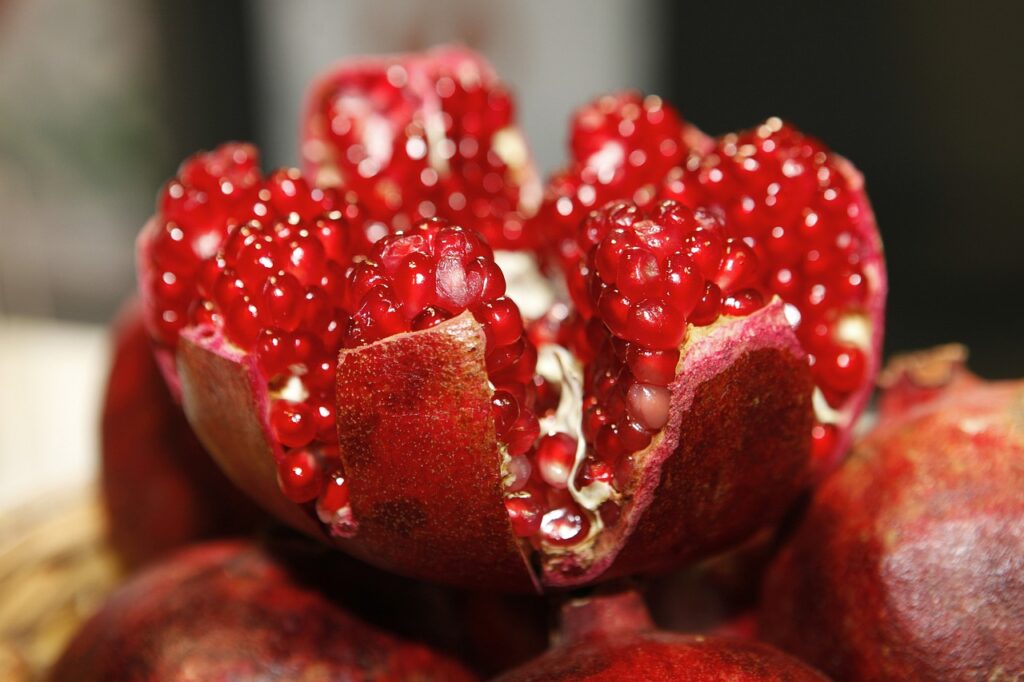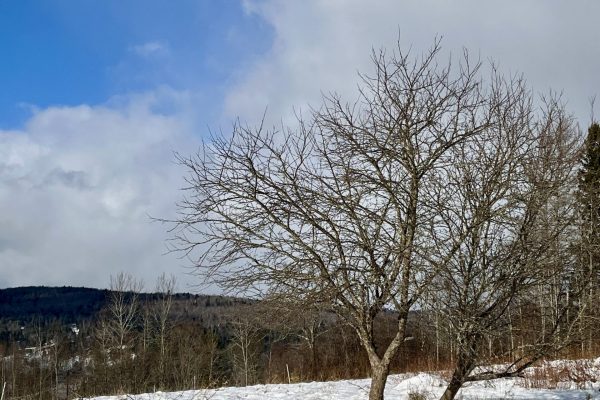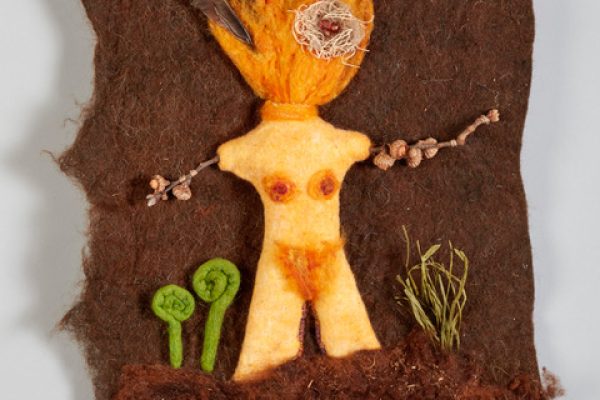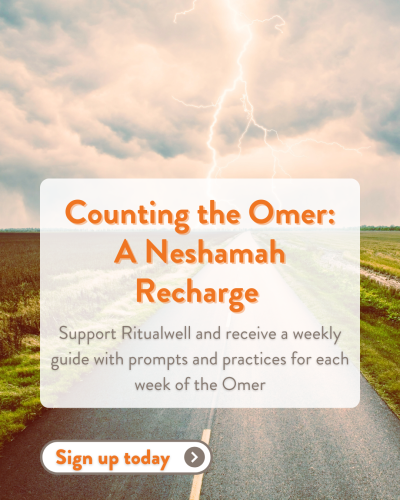Welcome to the JOFA Tu B’Shvat Seder
Tu B’Shvat is the new year for trees.1 While it may not feel like spring, an essential mystical approach is that on the 15th of Shevat, the sap begins to flow within the trees and plants of Israel—invisible to the human eye, but marking the beginning of spring nonetheless.
In the 16th century, kabbalists living in Safed incorporated some structural aspects of the Passover seder and performed a Tu B’Shvat seder. It is more accurate to call the text a “tikkun“ rather than a haggadah, since there was no real “telling” of a story, the hallmark of the Passover haggadah. Instead, they offered the prayer that their words succeed in fixing the world, that their words spiritually repair the Jewish nation and the individual soul.2
These mystics sought to uncover hidden mysteries of God’s wondrous creation of trees and fruits through relevant pesukim, midrashim, gematria, and observations of nature. What, for example, does it teach us about the nature of the universe that God created some fruits with inedible shells (pomegranates, oranges, grapefruits), some with inedible pits (dates, olives), and others that can be eaten whole (grapes, raisins, figs)?3
One of the earliest texts, entitled, “Peri Etz Hadar“ (translated as “Fruit of the Beautiful Tree”) centers around the etrog. The kabbalists prayed for a bountiful year and trees that would produce beautiful etrogim for Sukkot. They included 4 cups of wine, each of a different color, to symbolize the changing seasons.
During the course of this evening we will also drink 4 cups of wine, from white to red, and eat 15 various fruits, nuts and grains beginning with the shivat haminim, the seven species for which the Torah praises the land of Israel.
We have divided our seder into four sections, beginning with pesukim related to the various fruit, and ending with a cup of wine. The First Cup of wine is white, a symbol of winter. We will discuss the origins of the Tu B’Shvat seder. We will also partake of wheat, barley and olives and discuss the seven species, shiv’at haminim.
The Second Cup of wine is a lightly tinted pink, symbolizing the first signs of spring and the budding of trees in Israel. We will look at some of the similarities between God’s creation of trees, their fruit and our own characteristics as individuals and as Jews. We will complete the seven species by eating dates, grapes, figs and pomegranates.
The Third Cup of wine is a darker rose-colored pink, as the trees and flowers continue to blossom. For this cup we will eat apples, pears, walnuts, almonds and apricots.
The Fourth Cup of wine is red, representing fruitfulness and abundance. We will discuss the seeds of redemption, Eretz Yisrael, and the messianic era. We will partake of carob, oranges and grapefruit—fruits associated with Israel.
We will begin by taking the First Cup of wine and inviting those called to read a section in turn:
THE FIRST CUP: Origins of the Tu B’Shvat Seder
Please take a cup of white wine.
Tu B’Shvat (or the 15th day in the month of Shevat—“tet-vav“ are the Hebrew letters that have the numerical value of 15) begins the counting of the new year for trees and their fruit regarding different tithes to be brought each year. Tu B’Shvat took on a more festive character for the Jews in galut, who used the occasion to celebrate and praise the Land of Israel and the renewal of the soil and its produce. We learn about the seven species for which the Torah praises Israel in Devarim 8:7–8:
For the Lord your God brings you into a good land, a land of brooks of water, of fountains and depths that spring out of valleys and hills; A land of wheat, and barley, and vines, and fig trees, and pomegranates; a land of olive oil, and honey.
כִּי יְהוָה אֱלֹהֶיךָ, מְבִיאֲךָ אֶל-אֶרֶץ טוֹבָה: אֶרֶץ, נַחֲלֵי מָיִם–עֲיָנֹת וּתְהֹמֹת, יֹצְאִים בַּבִּקְעָה וּבָהָר אֶרֶץ חִטָּה וּשְׂעֹרָה, וְגֶפֶן וּתְאֵנָה. וְרִמּוֹן; אֶרֶץ-זֵית שֶׁמֶן, וּדְבָשׁ
Ki Adonai eloheikha meviyakha el eretz tovah. Eretz nakhlei mayim–ayanot ut’homot yotzim babik’ah uvahar eretz khitah ushorah vegefen uteinah. Verimon eretz zet shemen udvash.
WHEAT
Praise the Lord, O Jerusalem; praise your God, O Zion.
For He has strengthened the bars of your gates;
He has blessed your children within you.
He makes peace in your borders, and fills you with the finest of the wheat. (Tehilim 147:12–14)
Shabkhi yerushalayim et Adonai; haleli elohayikh tzion
Ki khizak berikhei sh’arayikh; beyrakh banayikh bekirbekh.
Please take a wheat cracker:
בָּרוּךְ אַתָּה אֲדֹנָי אֱלֹהֵינוּ מֶלֶךְ הָעוֹלָם בּוֹרֵא מִינֵי מְזוֹנוֹת
Barukh atah Adonai, Eloheinu melekh ha-olam, borei minei mezonot.
Blessed are You, Lord our God, Kind of the Universe, who created various kinds of food.
BARLEY
(Please take some Barley. As you have already said the blessing, you can eat without an additional blessing.)
Barley is the first grain to ripen each year. We start counting the omer in approximate correspondence with the start of the barley harvest, and end with the start of the wheat harvest. The story of Ruth takes place against the backdrop of the barley harvest:
So Naomi returned, and Ruth the Moabite, her daughter-in-law with her, who returned from the country of Moab; and they came to Beth-Lehem at the beginning of the barley harvest. (Ruth 1:22)
וַתָּשָׁב נָעֳמִי, וְרוּת הַמּוֹאֲבִיָּה כַלָּתָהּ עִמָּהּ, הַשָּׁבָה, מִשְּׂדֵי מוֹאָב; וְהֵמָּה, בָּאוּ בֵּית לֶחֶם, בִּתְחִלַּת, קְצִיר שְׂעֹרִים
Vatashav No’omi veRut hamo’aviyah khalatah imah, hashavah, mishdei Mo’av; veheimah ba’u Beit Lekhem bitkhilat ketzir sh’orim.
OLIVES
Olive oil is a source of holy light, both as the “eternal light” (the “ner tamid“) as well as the light on Chanukah:
The Torah specifies that the oil of olives be used for the ner tamid:
And you shall command the people of Israel, that they bring you pure beaten olive oil for the light, for the lamp to burn always. In the Tent of Meeting outside the veil, which is before the Testimony, Aaron and his sons shall order it from evening to morning before the Lord; it shall be a statute forever to their generations on behalf of the people of Israel. (Shemot 27:20-21)
וְאַתָּה תְּצַוֶּה אֶת-בְּנֵי יִשְׂרָאֵל, וְיִקְחוּ אֵלֶיךָ שֶׁמֶן זַיִת זָךְ כָּתִית–לַמָּאוֹר: לְהַעֲלֹת נֵר, תָּמִיד. בְּאֹהֶל מוֹעֵד מִחוּץ לַפָּרֹכֶת אֲשֶׁר עַל-הָעֵדֻת, יַעֲרֹךְ אֹתוֹ אַהֲרֹן וּבָנָיו מֵעֶרֶב עַד-בֹּקֶר–לִפְנֵי יְהוָה: חֻקַּת עוֹלָם לְדֹרֹתָם, מֵאֵת בְּנֵי יִשְׂרָאֵל
Ve’atah tetzavei et bnei yisrael, veyik’khu eilekha shemen zayit zakh katit–lama’or: Leha’alot ner tamid. Be’ohel mo’ed mikhutz laparokhet asher al ha’eidut ya’arokh oto Aharon uvanav mei’erev ad boker–lifnei Adonai: Khukat olam ledorotam, mei’eit benei yisrael.
And, of course, the olive branch is the universal symbol of peace.
Please take an olive and say the blessing:
בָּרוּךְ אַתָּה אֲדֹנָי אֱלֹהֵינוּ מֶלֶךְ הָעוֹלָם בּוֹרֵא פְּרִי הָעֵץ
Barukh atah Adonai, Eloheinu melekh ha’olam, borei peri ha’etz.
Blessed are You, God our God, King of the universe, Who creates the fruit of the tree.
[Please note: If you later eat a fruit during the seder that you have not yet eaten this season you should say the “Shehekheyanu” at that time, without the blessing of “Borei peri ha’etz.“
בָּרוּךְ אַתָּה אֲדֹנָי אֱלֹהֵינוּ מֶלֶךְ הָעוֹלָם, שֶׁהֶחֱיָנוּ וְקִיְּמָנוּ וְהִגִּיעָנוּ לַזְּמָן הַזֶּה
Barukh atah Adonai, Eloheinu melekh ha’olam, shehekheyanu, vekiyemanu, vehigi’anu, lazman hazeh.
Blessed are you, God, our God, King of the universe,
Who has kept us alive, sustained us, and brought us to this season.]
Lift the first cup of wine:
בָּרוּךְ אַתָּה אֲדֹנָי אֱלֹהֵינוּ מֶלֶךְ הָעוֹלָם בּוֹרֵא פְּרִי הַגָפֶן
Barukh atah Adonai, Eloheinu melekh ha’olam, borei peri hagafen.
Blessed are you, God our God, King of the Universe, Who creates the fruit of the vine.
We take the Second Cup of Wine, a lightly tinted color. Please take and eat the rest of the fruits and nuts as they are mentioned.4
THE SECOND CUP: People and Trees.
DATES
“Devash” refers to date honey and not bee honey (Rashi) and, thus, dates from the date palm tree are considered to be among the seven species.
This Shabbat, we will read the haftarah of Devorah, who judged Israel as she sat under a palm tree5:
And Deborah, a prophetess, the wife of Lapidoth, judged Israel at that time. And she lived under the palm tree of Deborah between Ramah and Beth-El in Mount Ephraim; and the people of Israel came up to her for judgment. (Judges 4:4)
וּדְבוֹרָה אִשָּׁה נְבִיאָה, אֵשֶׁת לַפִּידוֹת–הִיא שֹׁפְטָה אֶת-יִשְׂרָאֵל, בָּעֵת הַהִיא. וְהִיא יוֹשֶׁבֶת תַּחַת-תֹּמֶר דְּבוֹרָה, בֵּין הָרָמָה וּבֵין בֵּית-אֵל–בְּהַר אֶפְרָיִם; וַיַּעֲלוּ אֵלֶיהָ בְּנֵי יִשְׂרָאֵל, לַמִּשְׁפָּט
U’Devorah ishah neviah eshet lapidot hi shoftah et yisrael ba’et hahi. Vehi yoshevet takhat tomer Devorah, bein haramah uveyn beit el behar Efraim veya’alu eileha benei yisrael, lemishpat.
The righteous flourish like the palm tree, as a cedar in Lebanon. Those that are planted in the house of the Lord shall flourish in the courts of our God. (Tehillim 92:13)
SONG: TZADIK KATAMAR YIFRAKH
Tzadik katamar yifrakh k’erez balvanon yisgeh. Shetulim beveit Hashem bekhatzrot Elokeinu yafrikhu.
GRAPES
I found Israel like grapes in the wilderness;
I saw your forebears as the first ripe fruit in the fig tree at her first season. (Hoshea 9:10)
כַּעֲנָבִים בַּמִּדְבָּר, מָצָאתִי יִשְׂרָאֵל–כְּבִכּוּרָה בִתְאֵנָה בְּרֵאשִׁיתָהּ, רָאִיתִי אֲבוֹתֵיכֶם; הֵמָּה בָּאוּ בַעַל-פְּעוֹר, וַיִּנָּזְרוּ לַבֹּשֶׁת, וַיִּהְיוּ שִׁקּוּצִים, כְּאָהֳבָם
Ka’anavim bamidbar matzati yisrael kevikorah viteinah bereishitah ra’iti avoteikhem heimah ba’u ba’al pe’or veyinazru laboshet vayihyu shikutzim ke’ahavam.
“Why is Israel compared to a grapevine? When you want to improve its fruit, you dig it up and replant it elsewhere and it improves. So, when the Holy One wanted to make Israel known in the world, what did he do? He uprooted them from Egypt and brought them to the wilderness where they flourished. They received the Torah and became known throughout the world.” (Shemot Raba 44)
FIG
The fig is traditionally associated with peace:
“But they shall sit every man under his vine and under his fig tree; and none shall make them afraid; for the mouth of the Lord of hosts has spoken it. For let all people walk everyone in the name of his god, and we will walk in the name of the Lord our God forever and ever.” (Michah 4:4–5)
וְיָשְׁבוּ, אִישׁ תַּחַת גַּפְנוֹ וְתַחַת תְּאֵנָתוֹ–וְאֵין מַחֲרִיד: כִּי-פִי יְהוָה צְבָאוֹת, דִּבֵּר. הכִּי, כָּל-הָעַמִּים, יֵלְכוּ, אִישׁ בְּשֵׁם אֱלֹהָיו; וַאֲנַחְנוּ, נֵלֵךְ בְּשֵׁם-יְהוָה אֱלֹהֵינוּ–לְעוֹלָם וָעֶד
Veyashvu ish takhat gafno vetakhat te’einato ve’ein makharid: Ki fi Adonai tzeva’ot diber. Haki kol ha’amim yeilkhu ish beshem elohav. Ve’anakhnu neilekh beshem Adonai eloheinu le’olam va’ed.
Our sages have found many beautiful reasons to compare the fig tree to Torah:
“Why is the Torah compared to a fig tree? Because most trees—olive, grape, date—have their fruit picked all at once, but the fig fruit is picked little by little—so it is with the Torah: one learns a little of it one day and more the next, for it cannot all be learned in one year or two.” (Bamidbar Raba 12:9)
לָמָּה נִמְשְׁלָה תּוֹרָה כַּתְּאֵנָה שֶׁרֹב הָאִילָנוֹת הַזַּיִת הַגֶּפֶן הַתְמָרָה נִלְקַטִים כְּאַחַת וְהַתְּאֵנָה נִלְקֶטֶת מְעַט מְעַט וְכָךְ הַתּוֹרָה הַיּוֹם לוֹמֵד מְעַט וְלַמָּחָר הַרְבֵּה לְפִי שֶׁאֵינָהּ מִתְלַמֶדֶת לֹא הַשָּׁנָה וְלֹא בַּשָּׁתִים
Lamah nimshlah torah kateinah sherov ha’ilanot hazayit hagefen hatmarah nilkatim ke’akhat vehateinah nilketet me’at me’at vekhakh hatorah hayom hayom lomed me’at velamakhar harbei lefi she’einah mitlamedet lo hashanah velo bashatim.
“Why were the words of the Torah compared to the fig tree? As with the fig tree, the more one searches [the tree] the more figs one finds; so it is with the words of the Torah; the more one studies them the more meaning one finds in them. (Eruvin 4 a,b)
POMEGRANATES
Come, my beloved, let us go forth into the field;
let us sleep in the villages.
Let us rise early to the vineyards; let us see if the vine has flowered,
if the grape blossoms have opened, if the pomegranates are in bloom… (Shir Hashirim 7:12)
Lekha dodi neitzei hasadei nalinah bakfarim. Nishkimah lakramim nireh im parkhah hagefen pitakh hasmadar heineitzu harimonim sham etein et dodai lakh.
“Has the pomegranate blossomed?’ These are the schoolchildren who sit and study torah, row by row, like pomegranate seeds.” (Shir Hashirim Raba 6,17)
WALNUTS—ALMONDS—APRICOTS
The midrash in Song of Songs Raba 6 likens the people of Israel to a walnut pile to show how we are all influenced by each other. If one walnut is removed, each and every walnut in the pile will be shaken.
We drink the Second Cup of Wine. (Since we have already said the blessing on the first cup of wine, we need not make another blessing on the other cups.)
Please take the Third Cup of Wine.
THE THIRD CUP: A Time for Every Season…
To every thing there is a season, and a time for every purpose under heaven;
A time to be born, and a time to die;
A time to plant, a time to uproot that which has been planted;
A time to kill, and a time to heal; a time to break down, a time to build up;
A time to weep, and a time to laugh; a time to mourn, and a time to dance…
A time to keep silence, and a time to speak;
A time to love, and a time to hate; a time of war, and a time of peace. (Kohelet 3:1–2)
There is a time to plant trees, Kohelet teaches, and a time to uproot. Indeed, there is a time and season for every purpose. Often the question is, in which time do we live?
On this coming Shabbat, Shabbat Shirah, we will read of Yitzyiat Mitzrayim, a glorious time for Am Yisrael. Shirat Hayam, ends with Miriam’s song, in which she is called a “prophetess” and leads the women in song and dance to the accompaniment of timbrels6. Rashi writes that the righteous women of that generation possessed great insight and faith. So certain were they that God would bring them out of Egypt and perform miracles, that they brought their instruments with them out of Egypt7. They had faith that they would be singing a song of victory, that it would be, in the words of Kohelet, a time to dance.
Hatam Sofer implies that the women possess a higher level of faith that sustained them during times of challenge8. He writes that when Moshe ascended Har Sinai, the men feared that Moshe would not return and perhaps for this reason built the golden calf. The women understood, however, that even had Moshe not returned, there would be another prophet with whom the Shechinah would rest.
This Shabbat also includes the Song of Devorah in the Haftorah. She is also a model of great faith and insight—she led the nation through a time of war, and then on to a time of peace.
APPLE—PEAR
The apple tree has a special fragrance:
“And the apple tree has the fragrance of Gan Eden and the fragrance of Gan Eden was that of a field of apples.” (Ta’anit 29b)
Jewish women gave birth to their children in the field in Egypt under apple trees. This is one reason the Gemara gives for requiring charoset at the Pesach seder:
R. Eleazar son of R. Zadok said: Charoset is a religious requirement. Why is it a religious requirement? R. Levi said: In memory of the apple-tree under which the Jewish women in Egypt gave birth to their children. (Pesachim II6a)
And the Gemara teaches (Sotah IIb) that “the reward for the righteous women who lived in that generation was that the Israelites were delivered from Egypt”. Those women realized the importance of continuing to ensure the survival of Am Yisrael despite demoralization and degradation. They understood the time in which they lived and had faith that Am Yisrael would be redeemed.
We drink the third cup of wine.
Please take the Fourth Cup of Wine.
THE FOURTH CUP: Israel, Renewal and Redemption
R. Yohanan Ben Zakai used to say: “If you have a sapling in your hand and they tell you ‘The Messiah is coming!’ first plant the sapling and then go to greet him.” (Avot D’Rabi Natan)
רַבִּי יוֹחָנָן בֵּן זַכָּאי הָיָה אוֹמֵר אִם הָיְתָה נְטִיעָה בְּתוֹךְ יָדֶךָ וְיֹאמְרוּ לְךָ הֲרֵי לְךָ הַמָּשִׁיחַ בֹּא וְנָטַע הַנְּטִיעָה וְאֶחָד כָּךְ צֵא וְהַקְבִּילֵהוּ
Rabi yokhanan bein zakai hayah omer im haitah neti’ah betokh yadekha veyomru lekha harei lekha hamashiakh bo venata hanti’ah ve’ekhad kakh tzei vehakbileihu.
Trees are called an “everlasting Ot” or “sign” from haShem, like the rainbow.9
CAROB
Once Honi the circle-maker was walking on the road and saw a man planting a carob tree. He said to him: “In how many years will this tree give fruit?” He answered: “In seventy years.” Honi asked him, “Are you so healthy that you will live seventy years and eat its fruit?” And he replied, ” I found the world full of carob trees when I came into it, and as my fathers planted for me, so will I plant for my children.” (Taanit 23A)
ORANGES—GRAPEFRUIT
These are the last of the 15 fruits. They symbolize our return to Eretz Yisrael and its renewal and rejuvenation. The blooming of Israel, with the flourishing of trees and fruit therein, has been described as the clearest possible sign that the Messiah is coming:
R. Abba also said: There can be no more manifest [sign of] redemption than this… When Eretz Yisrael becomes so very fertile, Mashiakh’s coming is near, and there can be no clearer sign than this (Rashi). (Sanhedrin 98a)
CONCLUSION
We spoke before we began our seder of the spiritual hashkafa of the kabbalists. Central to their celebration of Tu B’shvat was the prayer that God provide a beautiful etrog for the coming Sukkot. In closing, we would like to add that a unique characteristic of the etrog tree is that it is constantly adorned with its fruit because the fruit takes several years to ripen. Thus, it is a tree that is never bare; the ripe fruit remains on the tree while the new fruit appears. (See Rashi, Vayikra 23:40 and Ramban, Malbim and Biur on this pasuk.)
May we, too, merit to always find the Torah, our Etz Chaim, adorned with new fruit, like the etrog tree.
May we have the privilege of continuing to discover new understanding and insight as one who searches for and finds the fruit of the fig tree.
May we find the holiness and faith that guided the noble women praised on Shabbat Shirah as Am Yisrael today faces a time of great uncertainty.
May God guide us and our leaders down the path of faith, mitzvot, love of Israel, Jerusalem, our people and peace…
Before you leave tonight please be sure to pick up a package of parsley seeds that you can plant in your home. Plant the seeds soon so that they can grow by Pesakh.
We hope that you will use the parsley at your seder where again we recount the glory of yitziyat Mitzrayim and Shirat HaYam when we stood together as one people, Am Yisrael, Kadosh umikudash.
Let us drink the fourth cup of wine and pray.
לְשָׁנָה הַבָּאָה בִּירוּשָׁלַיִם הַבְּנוּיָה
leshanah haba’ah birushsalayim habnuyah
NEXT YEAR IN JERUSALEM
————————-
Republished with permission by the Jewish Orthodox Feminist Alliance.












